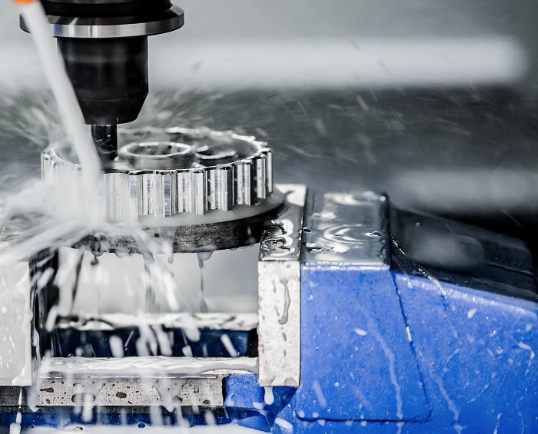CNC coolant or cutting fluid is an industrial fluid commonly used in metal cutting operations to increase efficiency. CNC machining coolant is made of special chemical additives that are scientifically compounded and concentrated. Its main ingredients include animal fats, water, petroleum distillates, vegetable oils and other raw materials.
These coolants improve the ability of CNC machines to cut materials such as high-density plastics, fiberglass and metals while reducing high-temperature buildup.

How does the cooling system work?
During CNC machining, a CNC machine tool coolant mixture flows through the work area. Coolant floods away debris and particles from the work area. It then flows into a sink at the base of the machine where you have to pump and recirculate it to the work area for continuous use.
Coolant cools the workpiece during high-speed machining and lubricates the tool during low-speed machining. Therefore, CNC coolant increases the tool life by protecting the tool from corrosion and protecting the workpiece from deformation. To ensure optimal performance, you must monitor, maintain and adjust central and individual CNC machine coolant systems.
However, small coolant systems use less efficient components for oil separation and filtration, resulting in constant variations and larger changes in concentration levels. Therefore, it is best to use a coolant that is less susceptible to shaving contamination in smaller systems.
Various coolant delivery for CNC machine tools
Different CNC machine tools use coolants with different properties and pressures. Therefore, choosing the ideal coolant delivery mechanism for your CNC machine tool is essential. Failure to choose the right pressure can quickly drain a shop’s resources, while the wrong pressure can damage the workpiece or CNC tool. The following are several common coolant delivery methods in CNC machine tools:
Mist cooling mechanism
This method of coolant delivery uses low pressure and is suitable for operations where heat and chip removal are not primary concerns. Therefore, mist cooling does not subject the tool and workpiece to additional stress because no high pressure is applied.
Air cooling mechanism
Air cooling technology is not ideal for lubrication purposes but helps reduce heat and extract chips. Air cooling is less effective because it does not contain oil or water-based coolants.
Additionally, when working with more sensitive materials, air-cooled mechanisms are ideal for direct contact with the workpiece. However, it is suitable for plastic materials that are susceptible to thermal shock or rapid expansion, since direct coolant often causes the part to shrink.
Minimum Quality Lubricant (MQL) Mechanism
The top priority of every CNC shop is to gain a competitive advantage by improving shop efficiency, increasing output and reducing costs. Therefore, CNC shops often adopt MQL due to its environmental benefits.
The MQL mechanism reduces costs and material waste by using the required amount of coolant. They are usually in the form of a very fine mist or aerosol that provides sufficient coolant to effectively perform the prescribed operation.
High pressure mechanism
During machining, high-pressure CNC machine coolant delivery uses pressures greater than 1,000 psi to remove chips. This method is ideal for extracting and draining chips because it blows the chip away from the material.
The pressure used in this method can damage micro-diameter tools, even though it cools the part quickly and efficiently. The method is therefore compatible with CNC drilling or deep cavity operations and is easy to transport with coolant or built-in coolant tanks.
PROTO MFG provides a wide range of manufacturing capabilities and other value-added services for all of your prototyping and production needs. Visit our website to learn more or to request a free, no-obligation quote.